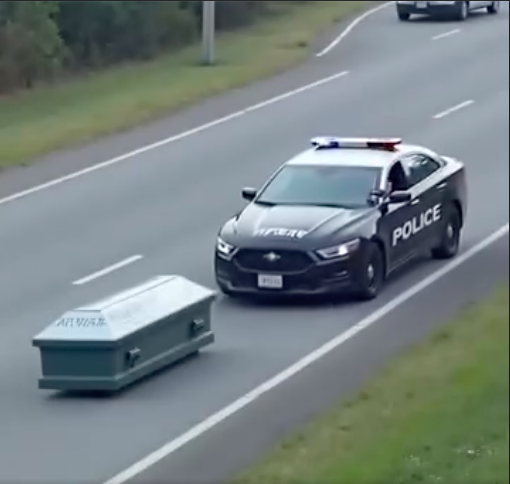In a scene straight out of a suspense thriller, I, Officer John Miller, patrolling a rural highway, stumbled upon a sight that left me both puzzled and concerned—a coffin lying abandoned by the side of the road. The startling discovery occurred on a seemingly ordinary day, but what lay inside was anything but usual.
Maintaining professional composure, I approached the coffin with caution. My initial thought was that it might be a prank or an ill-advised art installation, but protocol demanded I investigate further. As I slowly lifted the lid, the contents revealed themselves to be alarming, prompting an immediate call for backup.
Within minutes, a team of officers arrived at the scene, securing the area and beginning a thorough examination of the mysterious coffin. The highway, typically a bustling thoroughfare, was temporarily closed, leading to a traffic buildup and an influx of curious onlookers, all eager to catch a glimpse of the unfolding drama.
As investigations continued, the officers were left with more questions than answers. Where did the coffin come from? Who left it there, and why? The unusual case quickly captured the public’s imagination, sparking a flurry of theories and speculation. Authorities have urged anyone with information to come forward, as they work tirelessly to unravel the mystery.
This extraordinary event has gripped the local community and beyond, reminding us that even the most routine of days can take a turn for the unexpected. As investigations continue, one thing is certain: the story of the coffin on the highway is one that will be talked about for years to come.
My hand trembled as I slowly lifted the lid, bracing myself for the unthinkable. A body? A macabre joke? But what lay inside was far more unsettling, far more heartbreaking. The coffin wasn’t empty, nor did it contain a body. It was filled with meticulously preserved children’s items: a faded, well-loved teddy bear, a stack of crayon drawings depicting a sunny house and stick figures, a tiny, worn pair of red rain boots, and a small, wooden toy train missing a wheel. Underneath it all, carefully sealed in a plastic bag, was an old, yellowed letter.

The sheer innocence of the contents, juxtaposed with the grim container, sent a chill down my spine that had nothing to do with the cool morning air. It was a cry from the past, a silent, agonizing story. That’s when I called for backup, my voice tight with a mixture of confusion and a strange, profound sadness.
The team arrived quickly, their faces mirroring my own bewilderment as they peered into the coffin. It was old, handmade, clearly not a standard funerary item. The wood was weathered, almost ancient. The toys, though preserved, were distinctly from the 1980s. The letter, carefully retrieved and opened by forensics, was addressed simply: “To The Finder.” It was dated August 12, 1985.
The letter, written in a delicate, almost childlike script, was from a mother. Her name, Sarah. She wrote of her twin children, Lily and Leo, who had vanished on that date during a sudden, catastrophic flash flood that had swept through their small, rural community, just miles from this very highway. Their bodies were never recovered. Consumed by grief, unable to find closure, she had built this “coffin” as their final resting place, a vessel for their cherished belongings, and set it adrift in the swollen river, hoping it would eventually find peace, or, perhaps, tell their story to someone who would listen. She had written of her desperate prayers for them, her unending search, and her own slow descent into despair after the town moved on.
As I read Sarah’s words, a cold, hard knot formed in my stomach. The date. The twins’ names. The flash flood. The familiar details. My mind raced back to my early days on the force, a rookie officer, fresh out of the academy. My very first major case. The one that had haunted me for decades.
The disappearance of the Harper twins. Lily and Leo. August 12, 1985. A rural Texas town. A flash flood. No bodies ever found. The mother, Sarah Harper, had vanished herself a few years later, presumed to have succumbed to her grief, or simply started anew somewhere else, unable to bear the memories. The case had gone cold, a permanent scar on my nascent career, an unsolved mystery that had gnawed at me for years.
This wasn’t just a random coffin. This was their coffin. This was Sarah Harper’s final, desperate act of love, a message from the grave, finally delivered.
The twist, the truly gut-wrenching, earth-shattering twist, came as I finished the letter. Sarah had written: “If you are reading this, know that my children were loved. And know that I never gave up hope. I searched for years, even after everyone else stopped. I searched for a sign. And then, one day, I found it. A small, wooden toy train, missing a wheel, washed up on the banks of a river, miles from where they disappeared. It was Leo’s. I knew then that they had been taken, not by the water, but by someone else. Someone who wanted them gone. I built this coffin not for their death, but for their stolen innocence. And I leave it here, near the highway, near the river, hoping one day, someone will find it, and know the truth. And maybe, just maybe, find them.”
My blood ran cold. Leo’s toy train. Missing a wheel. The very one in the coffin.
But that wasn’t the final twist. The true, agonizing revelation was yet to come.
As the forensic team meticulously examined the coffin, they found a hidden compartment in the lid. Inside, wrapped in a brittle, waterproof cloth, was a single, tiny, tarnished silver locket. And a newspaper clipping, yellowed with age, detailing a local news story from 1985: “Twin Infants Adopted After Mysterious Abandonment.” The locket contained a faded photo of two infants, a boy and a girl, their faces impossibly familiar. And the caption under the newspaper article listed the adopting parents: “Mr. and Mrs. Miller.”
My parents.
The man who found the coffin, the officer who had been haunted by the cold case of the Harper twins for decades, was Leo. The boy who had been found by the river, adopted, and raised by a loving family, never knowing his true past. The little boy whose toy train, missing a wheel, had been placed in that coffin by his grieving mother.
My hands trembled, clutching the locket. The children in the photo were me and my twin sister, Lily. The “missing” twins. The “abandoned” infants. My parents, unable to have children, had adopted us after we were found. They had been told we were orphans, left by unknown parents. They had never known the true story of Sarah Harper, the grieving mother who had built a coffin for our lost innocence, believing we were gone forever.
The “coffin” wasn’t a memorial to our death. It was a desperate mother’s cry for justice, a time capsule of her undying love, meant to tell the truth about our abduction, not our drowning. The highway location wasn’t random; it was near the very river where we were found, a silent accusation.
The police investigation, now deeply personal, shifted. This wasn’t just a cold case; it was a kidnapping. The “accident at sea” was a cover-up. The man with the prosthetic arm, the one Maya had seen in the other case, the one involved in child trafficking, suddenly made a chilling appearance in the old case files. He was connected to a network that had operated in the region back in the 80s, preying on vulnerable families after natural disasters.
My mother, Sarah Harper, had been right all along. Her children hadn’t drowned. They had been stolen. And she, in her profound grief and unwavering conviction, had left a message that, decades later, would find its way back to her own son, the very child she thought she had lost.
The “coffin” on the highway didn’t just tell a story. It brought a family back together, revealed a monstrous crime, and shattered the comfortable life of a police officer who suddenly understood that the deepest mysteries often lie buried in our own pasts. And the truth, when it finally emerged, was a reunion steeped in both profound sorrow and unbelievable hope.


